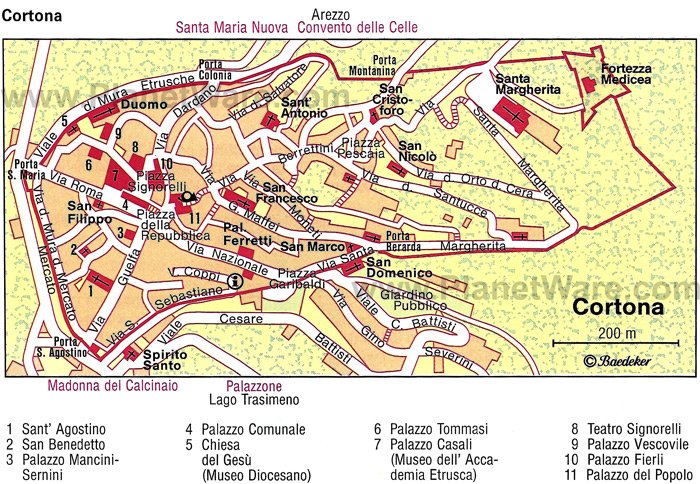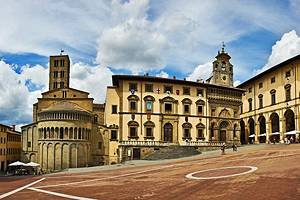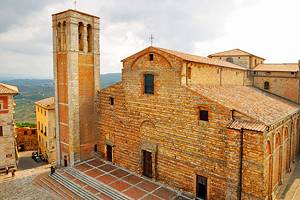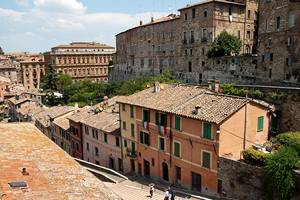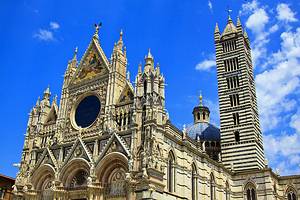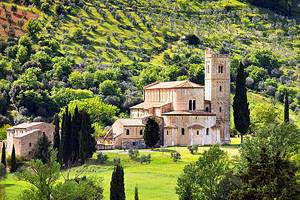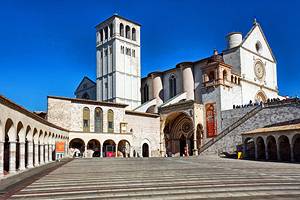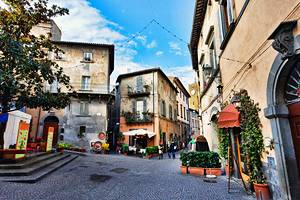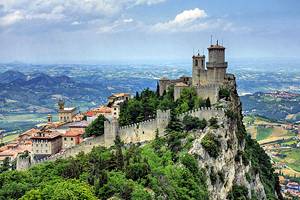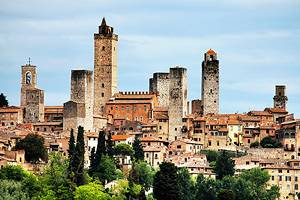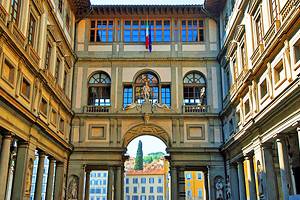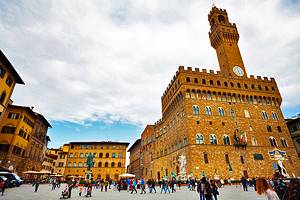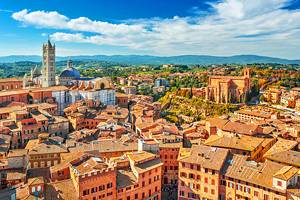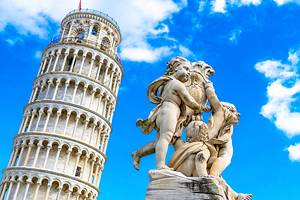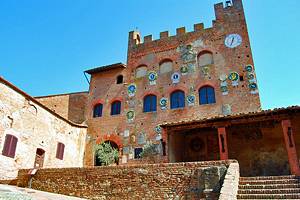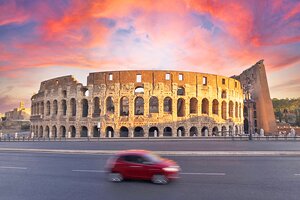Attractions & Things to Do in Cortona
Cortona was, until recently, one of the lesser known of the Tuscan hill towns, but suddenly gained attention as the location of Bramasole, the house that Francis Mayes made famous in Under the Tuscan Sun. As Mayes did, you'll find a lot to like about this walled hilltop town.
Close to the eastern border of Tuscany, Cortona is one of the oldest in Italy. It was one of the twelve cities of the Etruscan League and later became a Roman colony. After a century of self-rule as a city state in the 14th century, like so many other Tuscan towns, it came under the control of Florence at the end of the Middle Ages.
You'll see hints of Medici symbols and styles in its architecture. It was the Medici, in 1556, who ordered the construction of the bastions at the fortress of Girifalco, overlooking the town. Piazza della Repúbblica sits in its historic center, and most of Cortona's tourist attractions are within a short walk of this square.
Bramasole is an easy walk or short drive from the town center, on the road to Torreone, and although it is a private home, you can view the villa and beautifully kept grounds from the road. Find your own place under the Tuscan sun with all the things to do on this list of the top attractions in Cortona.
Convento delle Celle
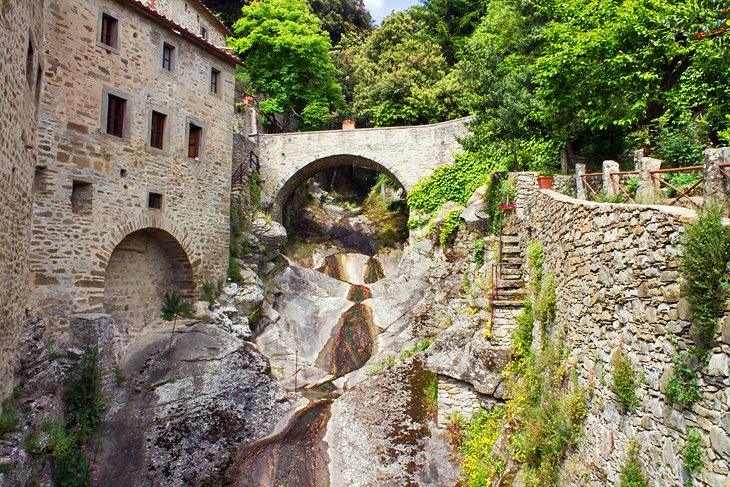
Without question the most popular of the places to visit in Cortona, the Convento delle Celle sits above a stream on the slopes of Monte Sant'Egidio. St. Francis of Assisi built the first of this complex of monks' cells between 1211 and 1221.
This was the first of the saint's hermitages, built four years before the Sanctuary of La Verna on Mount Penna, in the Casentino region about 60 kilometers north of Cortona. The saint chose this isolated spot in the woods as one conducive to prayer and contemplation and was soon joined here by followers, including Fra Elia da Cortona, who was to succeed St. Francis as head of the Franciscan order.
You can see the little church, built in 1573, and several cells, including the one used by St. Francis, altered very little from the way it looked when the saint lived here. This is one of the few to have remained in its original state and gives a good picture of the contemplative environment St. Francis preferred.
From here, there is an excellent view of Cortona on its hilltop. You can drive to the sanctuary or walk here from the center of Cortona in about an hour.
Location: Località Le Celle, Cortona
Museo dell'Accadémia Etrusca e della Città di Cortona (Archaeology Museum)
The Palazzo Pretorio houses the Accadémia Etrusca museum, containing Roman and Egyptian antiquities, as well as Etruscan material. Its greatest treasure is an Etruscan bronze lamp of the fifth century BC. Other priceless Etruscan bronzes include a statue of a winged goddess from the seventh to sixth centuries BC and one of Jupiter hurling a thunderbolt, also from the seventh to sixth centuries BC.
The Egyptian section of the museum displays a rare funerary boat of painted wood from the 12th Dynasty, about 2000 BC, in addition to several sarcophagi. There are also coins, medals, ceramics, and paintings by Italian masters of the 13th to 17th centuries.
Address: Palazzo Casali, Piazza Signorelli 9, Cortona
Santuario di Santa Margherita
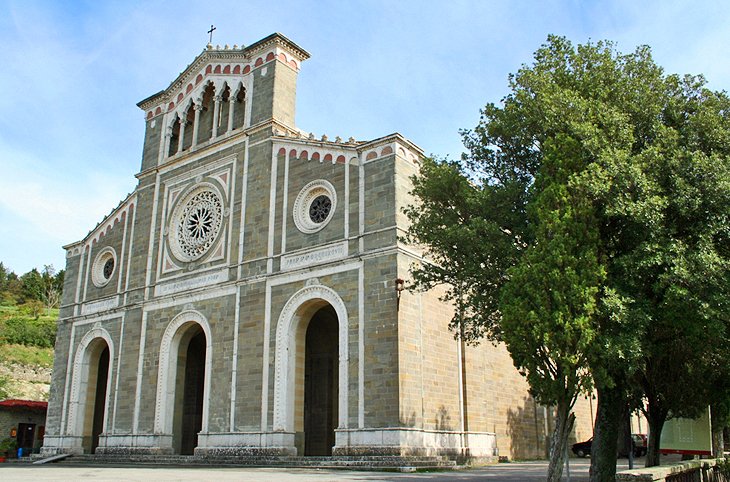
Set on a hillside, the Sanctuary of Santa Margherita is a pilgrimage church dedicated to St. Margaret of Cortona, who lived in the late 1200s. The present church, in Neo-Byzantine style, was built between 1856 and 1897, but the Saint's tomb dates from 1362; her relics are in a 1646 silver shrine behind the high altar.
A chapel on the left aisle is dedicated to Cortona's fallen soldiers. The façade is quite different from other Cortona churches, with intricate stone work and a beautiful rose window. From the square in front of the church is a magnificent view into the Val di Chiana.
If you plan to walk to Bramasole, setting for Under the Tuscan Sun, it is just over the hill from the sanctuary of Santa Margherita.
Address: Piazza Santa Margherita, Cortona
Fortress of Girifalco
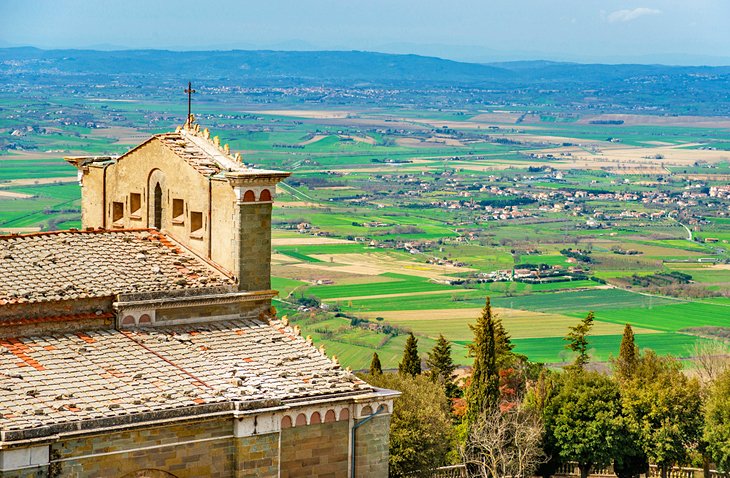
Etruscan walls originally protected the hilltop, but the fortress as we see it today began to take shape some time in the 11th or 12th century. By 1258, it was already described as a strong fortress, and was further fortified under the Medici in the early 16th century. Under the Medici, the fortress was connected to the town walls, and the four bastions were constructed.
Later, in the 16th century, those perpendicular walls were replaced with curtain walls and rounded bastions better suited to deflecting and withstanding barrages of cannon fire. But the only service it ever saw in war was as a radio post during World War II.
Today, it is a lively public arts and culture center, with frequent events and a restaurant serving local foods and drinks. It is one of the favorite viewpoints for admiring the surrounding Tuscan landscapes.
Address: Via di Fortezza, Cortona
Official site: http://www.fortezzadelgirifalco.it
Museo Diocesano (Diocesan Museum)
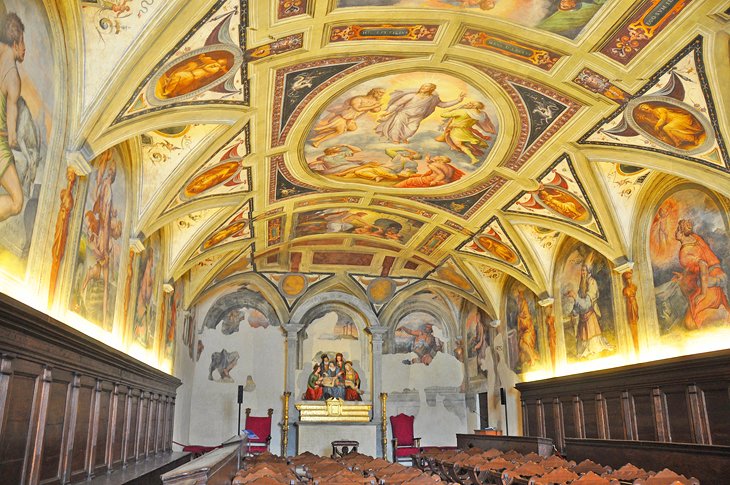
The deconsecrated Jesuit church, Chiesa del Gesù, is an unusual structure of two churches, one on top of the other. Originally built between 1498 and 1505, it was altered in the 16th century by Giorgio Vasari, and the upper church today houses the Diocesan Museum. Its best-known works are by Fra Angélico: Annunciation, a triptych with the Virgin and Child, and scenes from the life of St. Dominic.
Also worth noting are Pietro Lorenzetti's Crucifixion and Madonna; altar-pieces by Luca Signorelli and Sassetta; a Roman sarcophagus from the second century AD; and the 15th-century Vagnucci Reliquary of gilded bronze, silver, and precious stones. The lower church has rich fresco decoration painted or designed by Giorgio Vasari in the 16th century and a painted terra-cotta Descent from the Cross from about 1500.
Address: Piazza del Duomo 1, Cortona
San Francesco
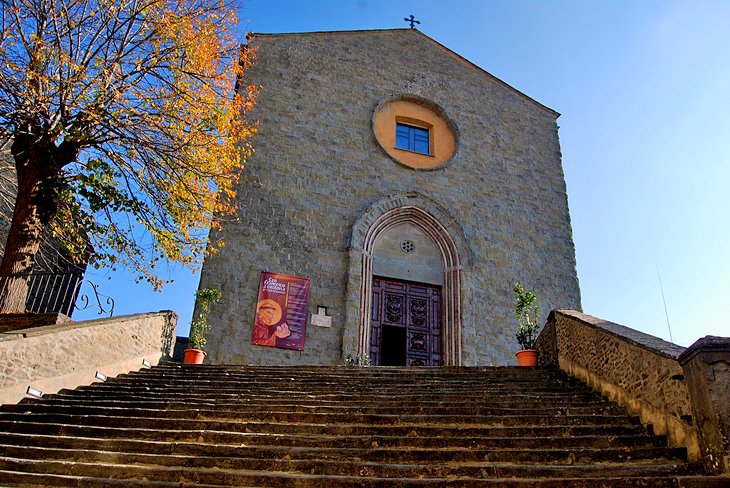
The church of San Francesco was begun in 1245, making it one of the earliest Franciscan churches. The exterior of this aisleless Gothic church is plain and undecorated; the interior was unfortunately remodeled in the Baroque period.
The greatest treasure, although it's not always visible, is a Reliquary of the True Cross, a Byzantine ivory tablet in a 16th-century frame, brought from Constantinople by Fra Elia da Cortona. Brother Elia succeeded St. Francis as leader of the order and founded this church; his tomb is in the choir.
Don't miss the masterpiece by Pietro da Cortona, The Annunciation, in the third altar on the left, considered one of the most beautiful paintings from the 17th century.
Address: Via Berrettini, Cortona
Cathedral
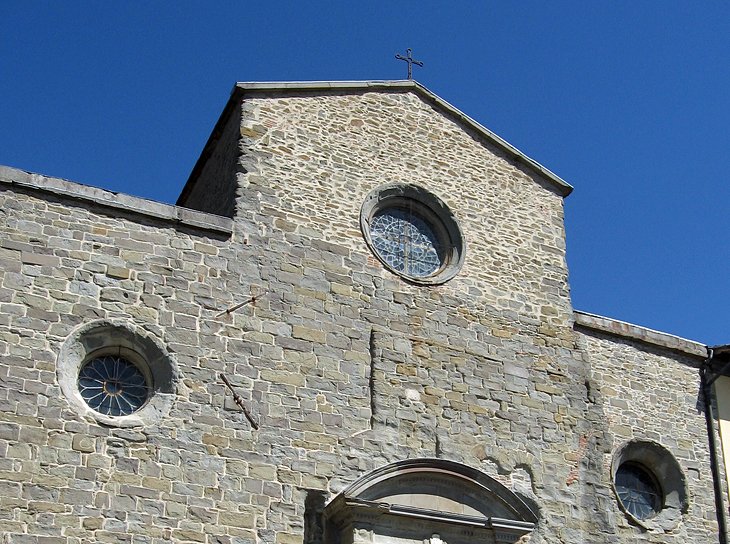
A short distance north of Piazza Signorelli, the cathedral of Santa Maria Assunta is a Renaissance structure built over an earlier Romanesque church. What you see today is predominantly the work of Giuliano da Sangallo (1445-1516) or his followers, and the beautiful portals are by Cristofanello, whose work can also be seen on the façade of a palazzo at Via Guelfa 4.
The interior is divided into three aisles by slender columns whose capitals reflect the style of Brunelleschi, architect of the great dome on the Duomo of Florence. The finely carved altars, done in the mid-1600s, are by Francesco Mazzuoli. The choir contains a number of good paintings, including some by pupils of Luca Signorelli.
Adjoining the cathedral is the Bishop's Palace (Palazzo Vescovile), whose present form dates mainly from the late 19th century.
Address: Piazza del Duomo, Cortona
Madonna del Calcinaio
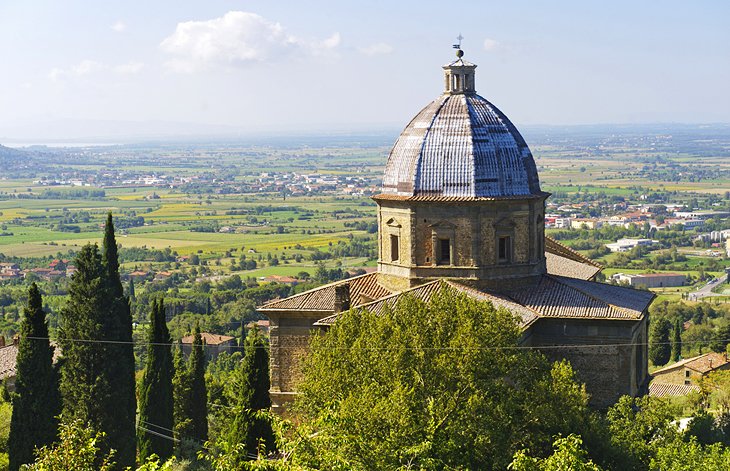
A twisting road descends the southern slope of the town to the Renaissance church of Santa Maria delle Grazie al Calcinaio, also called the Madonna del Calcinaio, a beautiful domed building on a cruciform plan by Francesco di Giorgio Martini of Siena.
The church was built to house a miraculous image of the Virgin, originally on the wall of a limestone quarry (calcinaio), belonging to the local Tanners' Guild and now on the high altar. Built from 1485 to 1513, this is one of the most architecturally important Renaissance churches in Tuscany.
Piazza della Repubblica
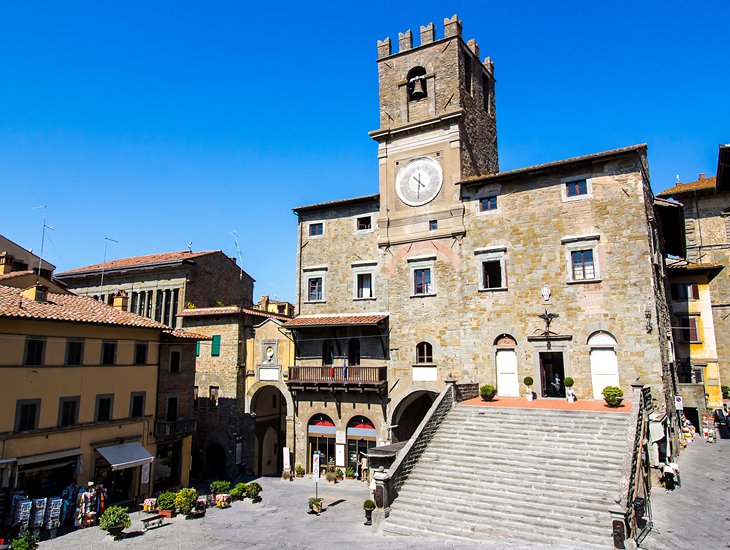
Piazza della Repúbblica, once the Roman Forum, sits in its historic center, overlooked by the 14th-century Palazzo del Pópolo and the imposing Palazzo Comunale, which was built before 1241. The front of the palazzo is somewhat forbidding, with a long flight of steps and a battlemented clock-tower, both part of 16th-century renovations.
The square itself is far from forbidding, usually filled with activity that includes everything from markets and festivals to street musicians and tourists browsing in the surrounding shops. For less touristed restaurants and shopping in Cortona, look to the side streets radiating from the piazza.
Cortona on the Move
This exhibition of modern and contemporary photography displays works of internationally important professional photographers in a number of exhibition venues and in public spaces throughout the town. This combination of paid and free locations opens the exhibits to everyone and draws the community into the show.
Among the venues is the fortress of Girifalco, at the top of Cortona; beginning here and following the exhibition route brings you to some of the finest overlooks, as well as the main things to see in Cortona. Other main exhibition sites are the Vecchio Ospedale and the former Magazzino delle Carni, both of which have been given new life as showcases for art.
Official site: https://www.cortonaonthemove.com
San Doménico
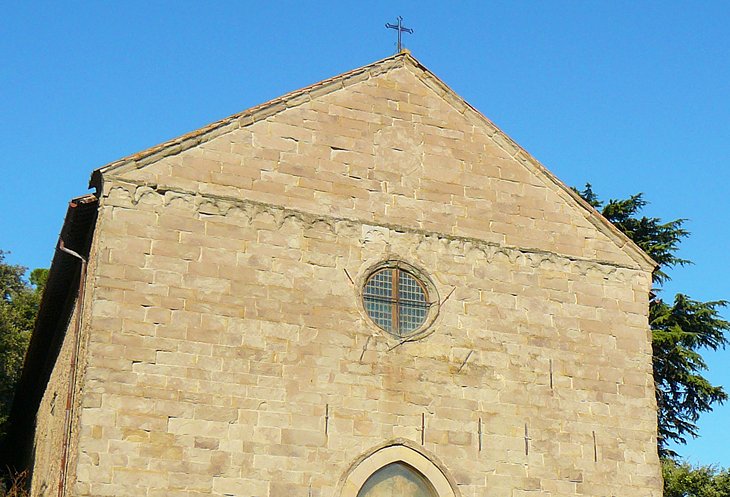
The church of San Doménico, outside the town walls to the south, was originally the church of a Dominican friary where the famous painter Fra Angélico lived for a time. This aisleless Gothic church was built in Fra Angélico's time, the early 15th century, in the plain architectural style favored by the Dominicans.
The simple façade has a lunette on the portal with a fresco, and you can see traces of pillars that were once part of a porch. The altar has a triptych by Lorenzo Gherini from the14th/15th centuries. In the chapel on the right is the 15th-century Madonna with Angels and Saints by Luca Signorelli, and on the wall of the presbytery is The Assumption by Bartolomeo della Gatta, also from the 15th century.
Address: Largo Beato Angelico 1, Cortona
Etruscan Tombs
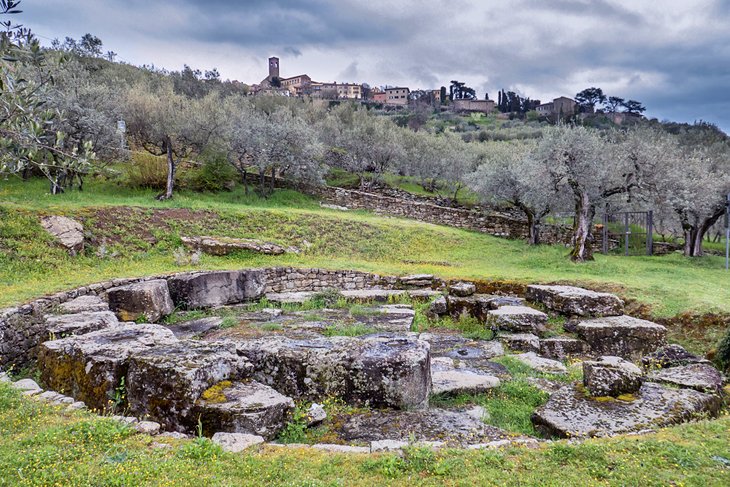
At the foot of Cortona's hill are two excellent Etruscan tombs. Melone I, excavated in 1909, yielded some of the fine examples of Etruscan funerary accessories shown in the Etruscan museum. Melone II, which was discovered in 1927, has an unusual terraced altar decorated by splendid decorative sculptures of combat between humans and mythical animals. This tomb is more than 70 meters in diameter.
The Tanella di Pitagora, just outside the city walls, is a tomb dating to the late 3rd or early 2nd century BC. The nearby Tanella Angori, dating back to the 2nd century BC, preserves the lower part portions and floor of the tomb. Another fourth-century tomb, south of Cortona, and reached by the road from the Porta Sant'Agostino, has a chamber more than two meters long enclosed by large wedge-shaped blocks.
Map of Attractions & Things to Do in Cortona
More Related Articles on PlanetWare.com
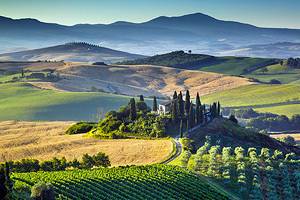
Discovering the Hill Towns of Tuscany: Medieval hilltop towns are among the tourist attractions in Tuscany and several more are within easy driving distance of Cortona. Closest is Arezzo, but you can also visit San Gimignano with its dozen medieval towers or Montepulciano; if Cortona's Etruscan attractions whetted your appetite for more, be sure to see the former Etruscan town of Volterra.
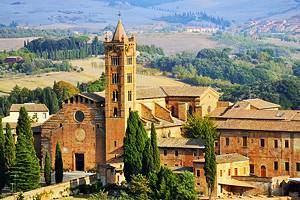
Seeing More of Tuscany: Our handy pages on the Tourist Attractions in Siena and Exploring Siena's Cathedral of Santa Maria Assunta can lead you to the best places to see in Siena, and Florence is not far away, with its magnificent Cathedral of Santa Maria del Fiori and the incomparable Uffizi Gallery, filled with Renaissance treasures.
